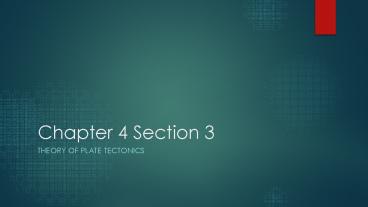Chapter 4 Section 3 - PowerPoint PPT Presentation
1 / 15
Title:
Chapter 4 Section 3
Description:
Chapter 4 Section 3 THEORY OF PLATE TECTONICS Language of the discipline lithospheric plate: a large brittle piece of Earth s outer shell plate tectonics: theory ... – PowerPoint PPT presentation
Number of Views:121
Avg rating:3.0/5.0
Title: Chapter 4 Section 3
1
Chapter 4 Section 3
- Theory of Plate Tectonics
2
Language of the discipline
- lithospheric plate a large brittle piece of
Earths outer shell - plate tectonics theory that explains how
lithospheric plate move and cause major geologic
features and events on Earths surface - ocean trench long, deep parts of the seafloor
- Slab plate that sinks back into the mantle
- Global Positioning System (GPS) a network of
satellites used to determine locations on
Earth
3
Language of the discipline continue
- Convection heat transfer by the movement of
matter from one place to another - Define to fix or mark the limits of
4
Earths Plates
- Lithospheric plates are large brittle pieces of
Earths outer shell. - The theory of plate tectonics explains the
movement of lithospheric plates.
5
Boundaries of Lithospheric Plates
- Mid-ocean ridges show boundaries of some
lithospheric plates - .
- Earthquakes and volcanoes occur where the edges
of plates are pushed together, pulled apart, or
slide horizontally. - Ocean trenches are the deep parts of the seafloor
where numerous earthquakes and volcanoes occur. - Seafloor is formed at ridges and destroyed at
ocean trenches.
6
Boundaries of Lithospheric Plates (cont.)
7
Types of Lithosphere
- Oceanic Crust thinner than continental, made of
dense igneous rock covered by a thin layer of
sediment (sand dirt) - Continental Crust thicker than oceanic made of
igneous and metamorphic rock covered by
sedimentary rock
8
What controls plate movement?
- Some scientists believe that convection controls
the movement of plates.
9
What controls plate movement? (cont.)
- Temperature increases with increasing depth.
- Radioactive decay is one important source of
internal heat. - Heat increases the temperature of rock which
decreases the density.
10
Plate Movement and Convection
- Slabs are cooler, denser lithospheric plates that
sink down into the mantle. - They bend and break as they sink down into the
mantle, causing earthquakes.
11
Ridge Push and Slab Pull
- Convection Cooler, denser masses of rock sink,
bringing plates with them. Less-dense rock is
brought to the surface at mid-ocean ridges. - Ridge Push The force of gravity moves the plate
downward and away from the mid-ocean ridges. - Slab Pull Gravity acts on denser plates,
pulling them into the mantle.
12
Ridge Push and Slab Pull
13
Plate Movement
- Global Positioning System (GPS) is a network of
satellites using radio waves to determine
locations on Earth. - Measures the movement of plates
- Using GPS and satellite laser ranging (SLR),
plate movement has been estimated at a few
centimeters per year.
14
GPS Satellite Laser Ranging in Plate Tectonics
- GPS (Global Positioning System) is a network of
satellites that uses radio waves to measure the
direction and speed of plates as they move along
Earths surface. - Satellite Laser Ranging (SLR) uses laser beams to
measure the distances of plate movements.
15
Checking for Understanding
- 1. What does the theory of plate tectonics
explain? - 2. What two types of lithosphere make up Earths
surface ? - 3. Why does the density of the surrounding rock
decrease (Think slabs?) - 4. What are GPS?
- 5. Use the term slab and ocean trench in a
sentence. - 6. A method used to determine the rate of plate
movement is ______. - 7. On the back of your paper draw a compare and
contrasting thinking map of the following
Convection, Ridge Push, and Slab Pull.































